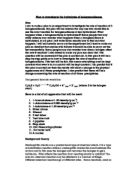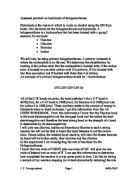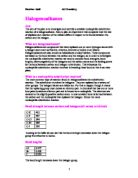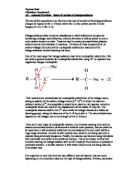The general formula would be:
C4H8X + H2O C4H8OH + H+ (aq) + X- (aq) (where X is the halogen atom)
Here is a list of all apparatus that will be used:
- 1-bromobutane at 1.28 density/g cm¯²
- 1-chlorobutane at 0.890 density/g cm¯²
- 1-iodobutane at 1.62 density/g cm¯²
- Silver nitrate
- Ethanol
- 3 test tubes
- Test tube rack
- 4 pipettes
- Stop clock
- 10ml Measuring cylinder
- Hot water bath
- A marker
Background theory
Nucleophilic attacks are a predominant type of chemical attack. It is a type of substitution reaction where a nucleophile breaks the bond between the carbon and in this case the halogen and removes the halogen to get a halide ion. What affects the reaction from reacting slowly or quickly? The rate of a chemical reaction may be affected by a number of things. Different chemical reactions go at different rates. Some reactions, such as burning fuel in a cylinder or precipitating silver chloride from solution go very fast. On the other hand, others such as the souring of milk or the rusting of iron are much slower reactions. Some other things that affect rate of reaction: The concentration of the reactants, the temperature, the particle size of a solid and the presence of a catalyst.
Nucleophilic substitution is when the halogen is substituted by a variety of other groups. When the halogen is substituted it will become a halide ion. This means that the atom that is replacing it must possess a lone-pair of electrons. This lone pair is donated to the positive carbon atom, and a new covalent bond is formed. The chemical that donates the lone-pair that causes the formation of a covalent bond is called a nucleophile.
(Where x represents a halogen)
Method:
The volume must be worked out in order for the person carrying out the test to know how much of each solution to use.
Volume = Mass Volume of 0.025moles = 2.3125
Density 0.890 = 2.6cm3
Use 0.025moles of each halogenoalkane
1. Label each of the test tubes either A, B or C. In each of three tests–tubes place 1 cm3 of ethanol using a pipette.
2. Using separate pipettes put 2.6cm3 of 1–chlorobutane in the first test–tube (A), 2.6cm3 of 1–bromobutane in the second test tube (B) and 2.6cm3 of l–iodobutane in the third test tube (C).
3. Place all three test–tubes in a test tube rack. Next measure out 4cm3 of Silver nitrate to add to the haloalkanes. Add the 4cm3 of Silver nitrate and add this to all three test tubes (A, B and C).
4. Now place the rack in a water bath with a temperature set at about 60–65 oC. Make sure the bath is hot and still turned on when the test tube rack is put in.
5. Record the time with three identical timers (same margin of error) and stop the timer when it's corresponding test tube displays a change. i.e. formation of a precipitate. The time for all three must be recorded separately, so we can see what the difference in rates of reaction. The formation of a precipitate shows the rate of hydrolysis of the haloalkanes.
7. Record the results in a table.
In order for the results to be reliable it is essential to carry out a fair test.
· You must accurately measure the amount of haloalkanes, silver nitrate and ethanol making sure they are all the same quantity in each test tube.
· You must start the timing as soon as you place the halogenoalkane in and stop as soon as a clear precipitate shows without shaking.
· You have to keep temperature, pressure and as mentioned before concentration.
RESULTS
The conclusion should begin with a brief evaluation. For example As can be seen 1-chlorobutane is the least reactive as it took the longest time however the rate of reaction increases as you go down decreases to 1-iodobutane.
This is how the results table should be set up. The results may not be similar, however they should still correspond to the hypothesis.
From these results I can see that 1-chlorobutane slowly produced a white precipitate of silver chloride. 1-bromobutane produced a white precipitate of silver bromide faster than the 1-chlorobutane, however the fastest was the 1-iodobutane, which produced a yellow precipitate of silver iodide the fast.
Sources of information:
http://www.rjclarkson.demon.co.uk/organi/organic3.htm
NAS Organic Chemistry, Energetics, Kinetics and Equilibrium
Cambridge Advanced Science Chemistry 1







